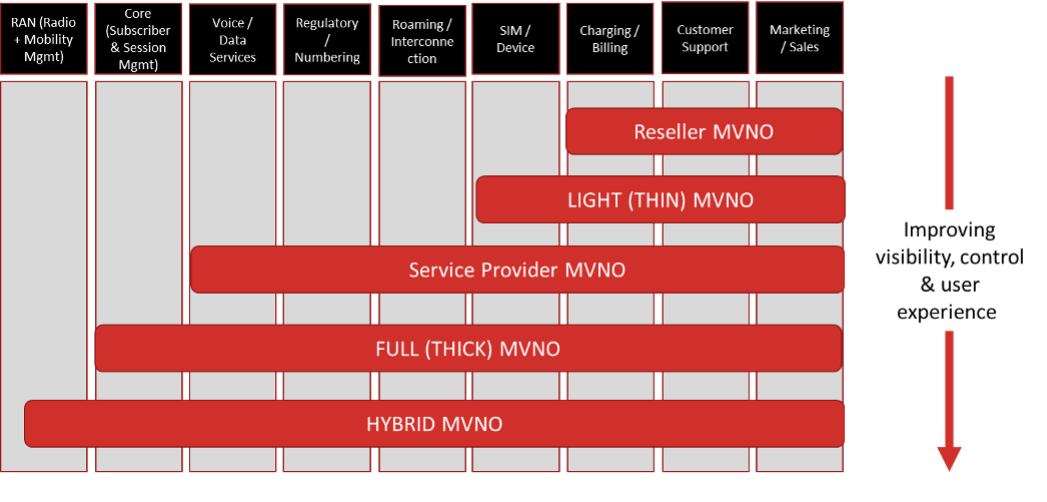Convergence
Introducing Evolved Mobile Virtual Network Operator (MVNO) Architectures for Converged Wireless Deployments

As smartphones and tablets continue to proliferate, seamless connectivity is becoming an integral part of a wireless operator’s service offering—as well as a competitive imperative. Recognizing the evolution of the mobile industry landscape, and driven by the introduction of 5G and the availability of new and innovative spectrum options, CableLabs and its members initiated a technical working group (Dec. 2020-Aug. 2021) to create an evolved architectural blueprint for mobile virtual network operators (MVNOs). The working group’s aim was to explore new converged architectures that will benefit our members’ wireless deployments while highlighting the benefits, impacts to existing deployments and features needed to be supported by both mobile network operator (MNO) and MVNO networks.
Background
Many traditional broadband services providers—also known as multiple system operators (MSOs)—might not own mobile infrastructure but have (or are in the process of negotiating) MVNO arrangements with MNOs. These kinds of arrangements allow them to bundle fixed and mobile broadband services into a single service package. Traditionally, most MSOs adopt a reseller-type “Wi-Fi first” MVNO, where the MVNO doesn’t own any mobile network infrastructure and resells the services leveraging MNO infrastructure.
Emergence of a New MVNO Model

The MVNO models vary based on the amount of mobile network infrastructure that the MVNO owns and the degree of control over the management of different aspects of MVNO subscriptions and their service offerings. One common aspect of all traditional MVNO models is leveraging the radio access network (RAN) of a partner MNO.
With the advent of 5G and the availability of shared spectrum, many MSOs are actively evaluating offload opportunities for enhancing MVNO economics and are contemplating deploying their own mobile radio infrastructure in specific geographic areas (in addition to their substantial Wi-Fi footprint).
Such MSOs now have to contend with three disparate sets of wireless infrastructures:
- the MSO’s community Wi-Fi network,
- the MNO’s 4G/5G network, and
- the MSO’s own 4G/5G network.
This creates a new type of MVNO model called hybrid-MVNO (H-MVNO) that enables MVNOs to offload their subscribers’ traffic from the MNO network—not just to their Wi-Fi networks but also to the MVNO-owned mobile network when inside the coverage footprint of their wireless network(s).
Maximizing data offload via the H-MVNOs’ own wireless assets—thus ensuring a consistent user experience and enforcing uniform and personalized policies as users move in and out of coverage of these three networks—will require the deployment of new converged network architecture and related capabilities.
Dual-SIM Architectures Evaluated by the Technical Working Group
Leveraging dual-SIM devices (devices with the ability to simultaneously connect to two networks) to realize this network convergence is the one way for an H-MVNO to maximize the use of its own network. Dual-SIM device usage allows the H-MVNO to leverage the existing reseller-type MVNO arrangements and require minimum interaction between the H-MVNO and MNO core networks.
However, leveraging the reseller MVNO with dual-SIM capabilities doesn’t offer the H-MVNO any real-time insights into their subscribers’ data usage statistics and patterns. Also, H-MVNOs have no control over policy, subscriptions, mobility or user experience management when their subscribers are outside H-MVNO network coverage.
This formed the basis of evaluating the new evolved Dual-SIM Dual Standby (DSDS) architectures, which leverage standardized 3GPP interfaces to overcome some of the limitations of the traditional reseller MVNO and provide more control to H-MVNOs with regard to policy, subscription and user-experience management by anchoring all subscriber data traffic in a common anchor within the H-MVNO network.
Voice handling with dual-SIM devices can be simplified by leveraging the MNO SIM and network for carrying voice traffic at all times, while prioritizing H-MVNO network (when available) for data traffic.
Single-SIM Architectures Evaluated by the Technical Working Group
Unlike architectures with dual SIMs, single-SIM devices allow the H-MVNO network to enable seamless low-latency mobility for data applications across the MNO and H-MVNO networks. An ideal architecture for offering mobile services with single-SIM device usage is to combine the roaming architecture and a mobility interface, both of which are standardized in 3GPP.
However, due to the targeted nature of H-MVNO mobile deployments, the signaling load can increase on MNO mobility management core network elements, as the H-MVNO subscribers move in and out of H-MVNO network coverage.
To overcome this problem, we evaluated new MVNO architectures that make use of dedicated network elements within the MNO domain to serve H-MVNO subscriber traffic, thereby isolating it from the MNO subscriber traffic and eliminating the increase in signaling load on core network elements that serve MNO subscribers.
In addition, we evaluated voice handling in scenarios where H-MVNOs don’t want to deploy their own voice platforms. One option is to offer voice via a third-party voice service provider; another is to enable additional interfaces between the MNO and the H-MVNO network to leverage the MNO’s voice platform.
Go Deeper
If you have any further questions, please feel free to reach out to the MVNO Interconnect Technical WG Lead, Omkar Dharmadhikari (o.dharmadhikari@cablelabs.com).
For more information, please visit:
- Mobile Summit Session #2 MVNOs (November 2020)
- MVNO Interconnect Phase 1 White Paper (May 2021)
- Evolved MVNO Architectures for Converged Wireless Deployments paper and presentation at SCTE Expo 2021 (October 2021)
- CableLabs Webinar on Evolved MVNO Architectures for Converged Wireless Deployments (October 2021)




